Like any other Indian, I too have a really, really soft corner for the ‘festival of lights,’ Diwali. Like not just the vibrancy all around during this time of the season, it’s the food, especially the sweets that I can never get enough of. Just like this Balushahi Recipe or Badusha Sweet which is a popular one in this festival. The Balushahi or Balushahi Sweet is a famous one from North Indian cuisine. In South India, it is popularly referred to as Badusha. This post has a fool-proof recipe for you to make this sweet at home.
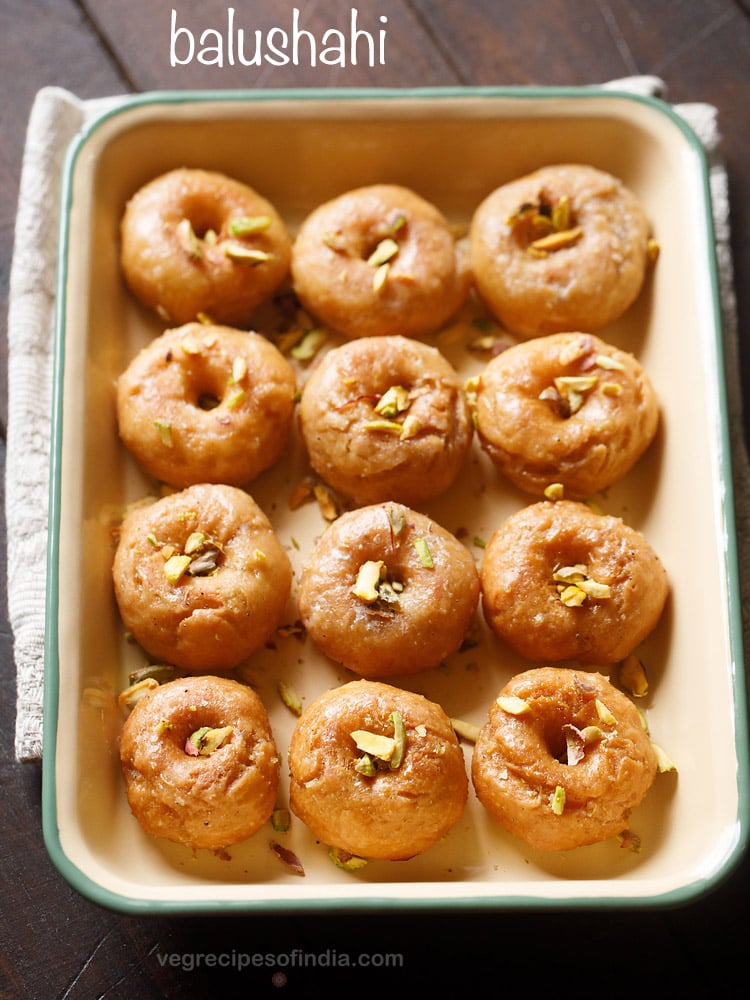
About Balushahi
At first sight, you might find the Balushahi or Badusha Sweet having a canny resemblance to the western glazed doughnuts. Well, in fact, it does look a lot like it. But there’s still somethings that make both these classic sweets distinct in their own way.
From the taste to the texture, an Indian Badusha or Balushahi Sweet is totally different than its international colleague doughnut. Traditionally, a Balushahi Recipe has all-purpose flour (maida) and sugar syrup as primary ingredients.
The flour dough is shaped into these roundels with a dent in the center, deep-fried and then soaked in sugar syrup which sweetens them.
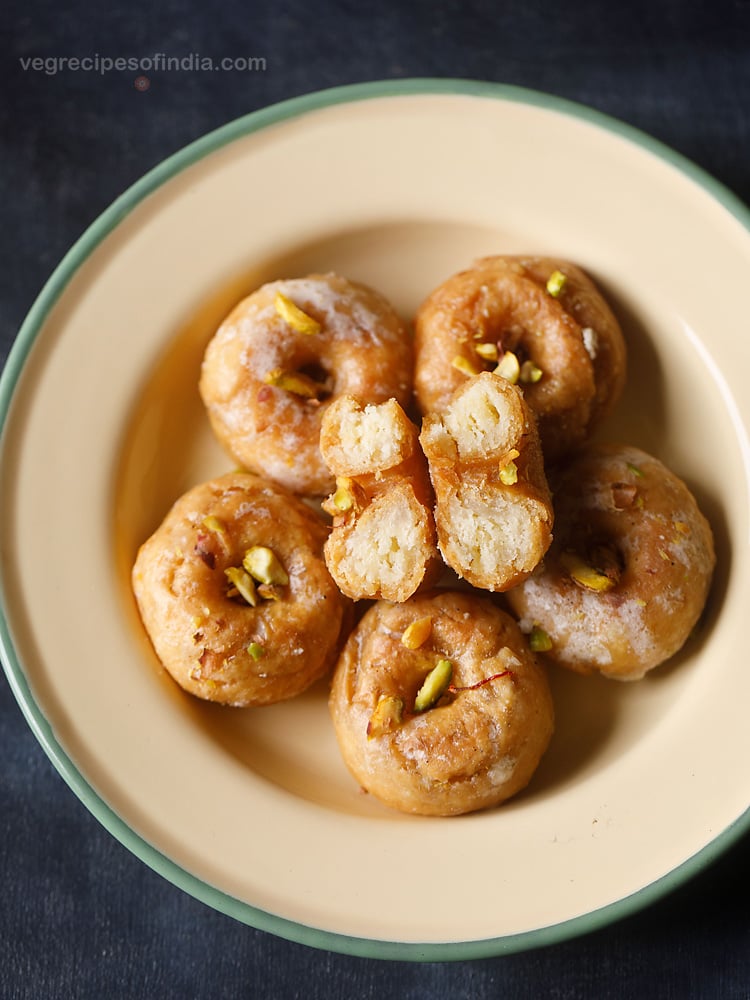
Also, while a doughnut has a light and fluffy texture, these Indianized doughnuts are not fluffy. These have a soft and flaky texture. A doughnut also has a certain softness outside, whereas this special Indian sweet has a crisp texture on the outside.
However, there may be certain recipe variations of a Balushahi Sweet that differ from individual to individual, or even in North and South India. Like for instance, the same sweet becomes the Badusha in South Indian cuisine which has a juicy texture and are a lot sweeter and flakier.
The Badusha Sweet is very common in almost all major states across South India – Tamil Nadu, Karnataka, Kerala, Andhra Pradesh and even Telangana. Other than India, other countries like Pakistan and Bangladesh too have their own version of the Balushahi Recipe.
More On My Recipe
You can easily get Balushahi or Badusha in all sweet (mithai) shops. But I usually avoid buying sweets or snacks from the market and make them at home. Especially, during festivities like Diwali celebrations and others.
This Balushahi Recipe is a tried and tested one, and gives you a really delish batch of the Badusha Sweet. The Balushahi Sweet made with this recipe results in a taste exactly like the ones made by halwais at mithai shops. The outside is crisp and the inside is soft and slightly flaky.
I would suggest following the recipe exactly, without making any changes. For the sugar syrup too, you need to cook it till you get a sticky, ½ or 1-string consistency in the syrup. Then keep it warm or hot while adding the fried sweets in it to soak.
Making this festive sweet is easy, and not difficult. You just need some time in hand. This recipe yields about 17 pieces of this sweet. You can store this sweet in an air-tight container or jar at room temperature for 5 to 6 days.
How to make Balushahi
Cream Ghee
1. Take ¼ cup (60 grams) ghee in a bowl. Make sure the ghee is in a semi-solid state and not runny or melted or in a cold solid block.
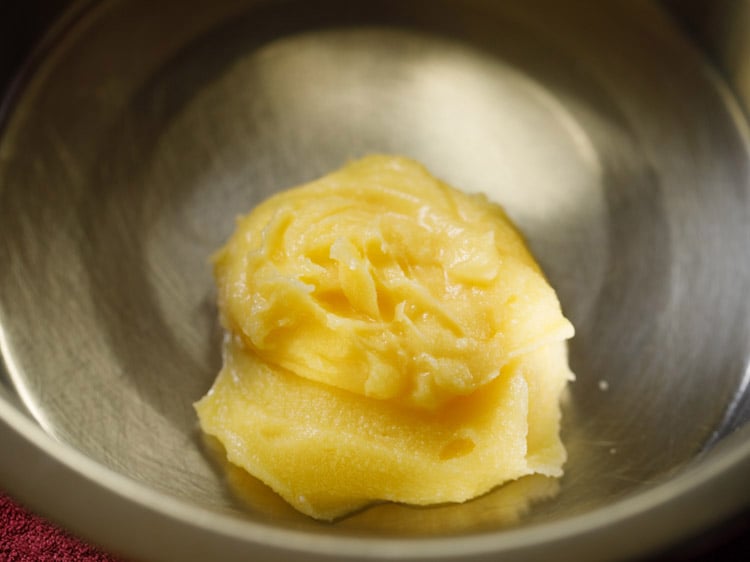
2. With a spoon, spatula or a small wired whisk, beat the ghee till it is smooth, light and fluffy. The color will also lighten.
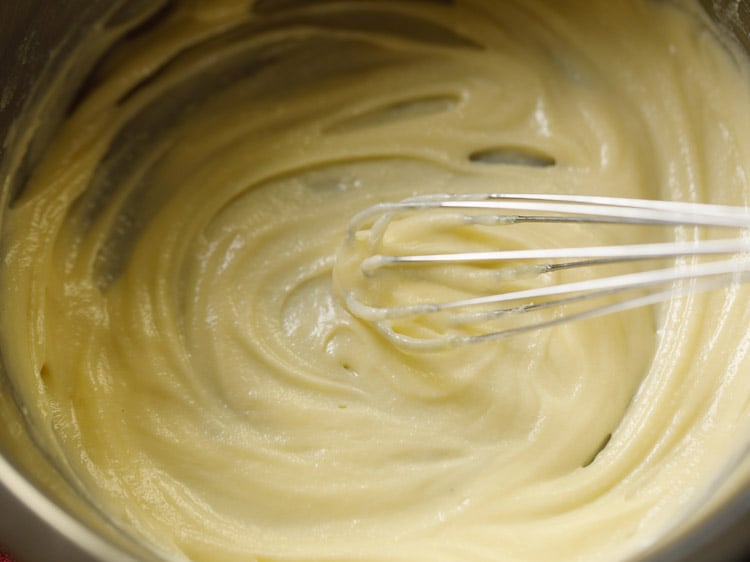
3. Add ¼ cup (60 grams) cold or chilled fresh curd (dahi).
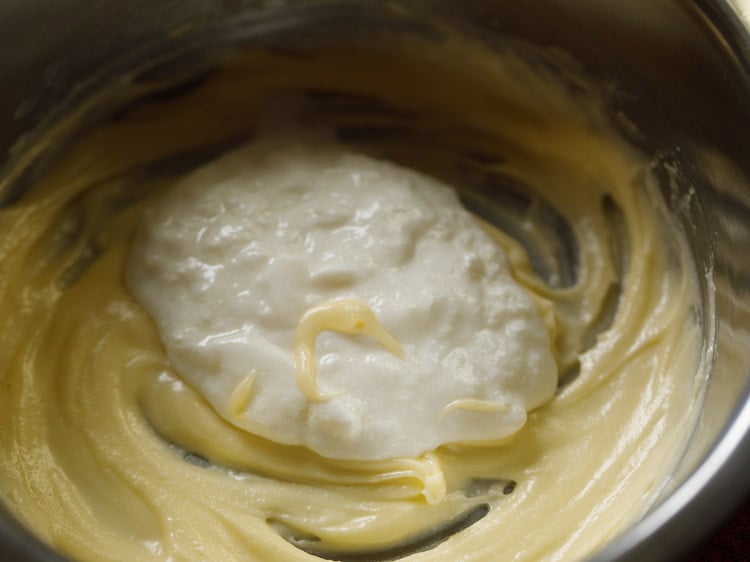
4. Again with a spoon, spatula or a small wired whisk, whip the curd with the creamed ghee.
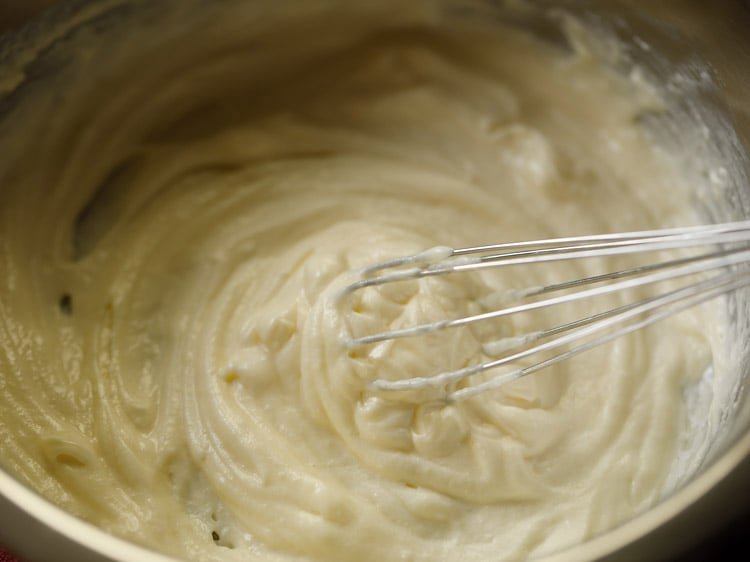
5. Cream till light and smooth.
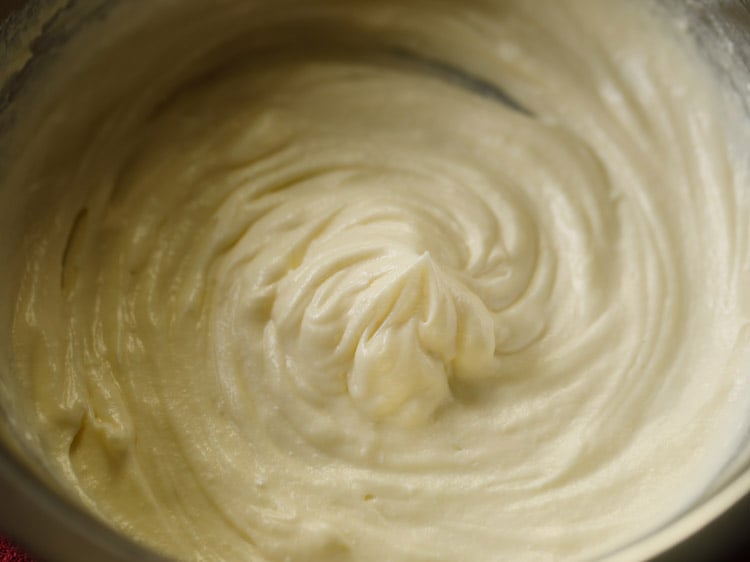
Make Balushahi Dough
6. Now, take 2 cups (250 grams) all-purpose flour (maida) in a sieve. Place it on the bowl itself. You can also sift the flour separately on a plate or tray.
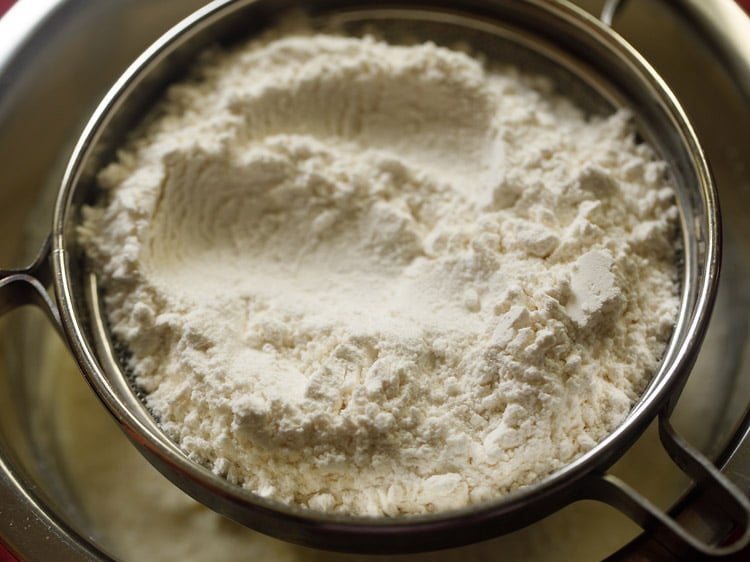
7. Add 1 pinch salt, 1 pinch baking soda and ½ teaspoon baking powder.
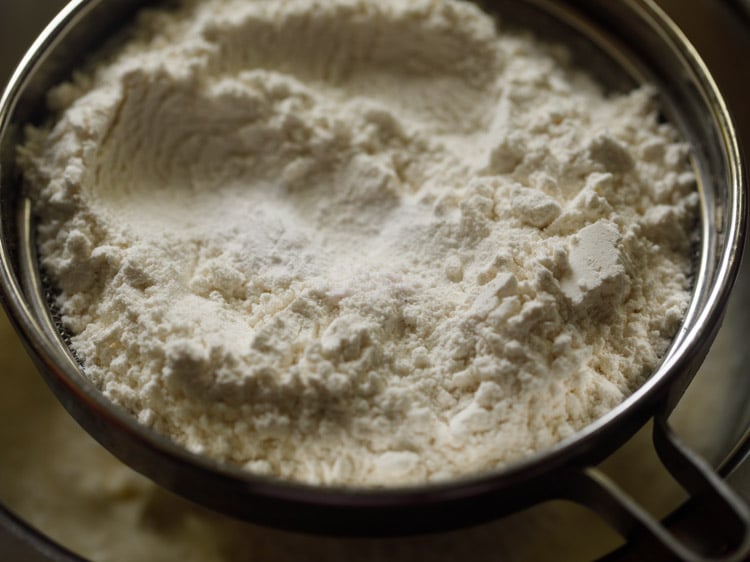
8. Sift directly in the creamed mixture.
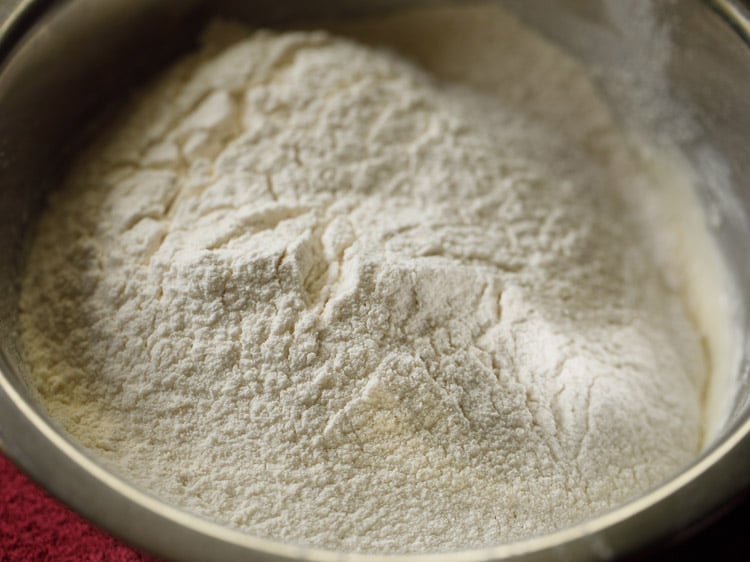
9. Mix the flour lightly with the creamed ghee and curd, using a spoon or spatula.
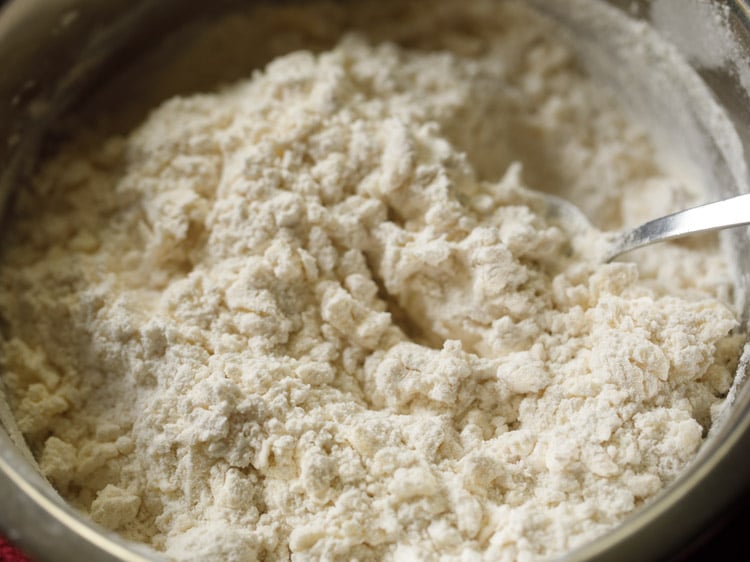
10. Sprinkle some cold water in parts and begin to mix it. Overall, you can use 8 to 9 tablespoons cold water.
Add 2 to 3 tablespoons water at a time and mix. If the curd used has more whey, then less water will be required.
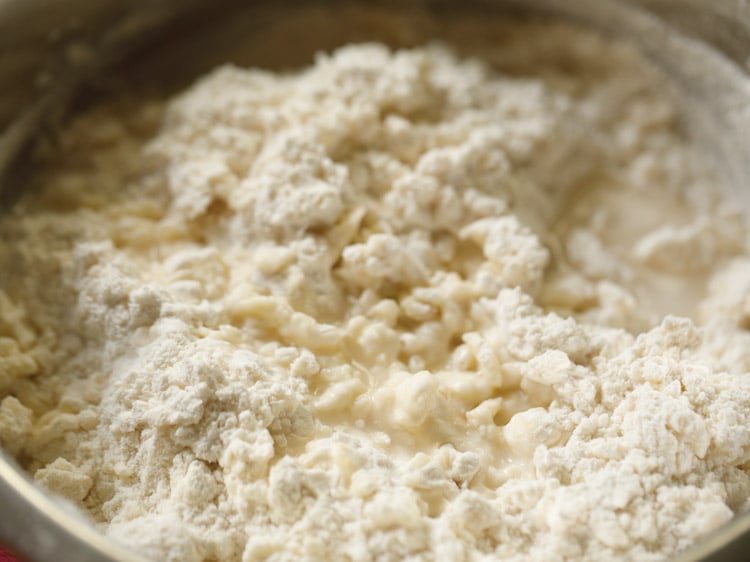
11. Mix and combine everything to form a soft dough. Do not knead. Just mix and bring everything together to a dough. Cover the dough and let it rest for 15 minutes.
In case the dough becomes sticky, add 1 to 2 tablespoons flour. Use light pressure from hands and form a dough. Do not knead heavily or if required, then knead very lightly.
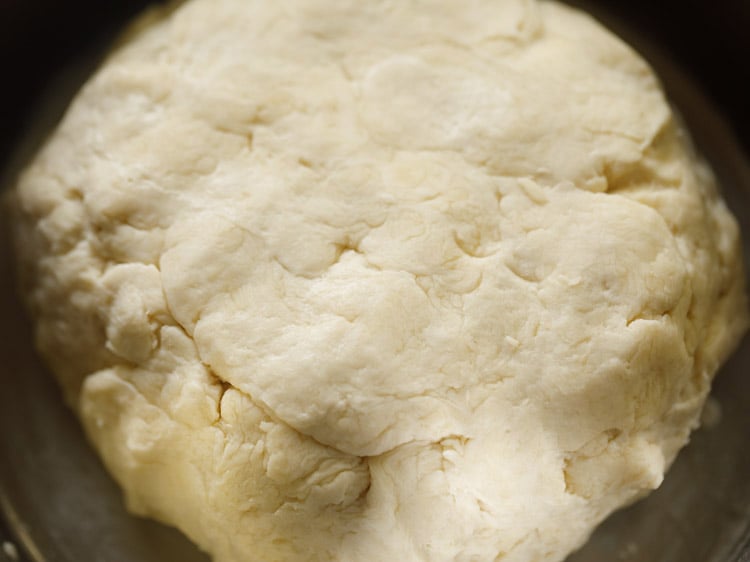
Make Sugar Syrup
12. Meanwhile make sugar syrup. Simultaneously, while frying also you can make sugar syrup.
Take 200 grams or 1 heaped cup sugar in a pan or bowl. Use a bowl or pan with more surface area so that the Balushahi can get enough space for soaking.
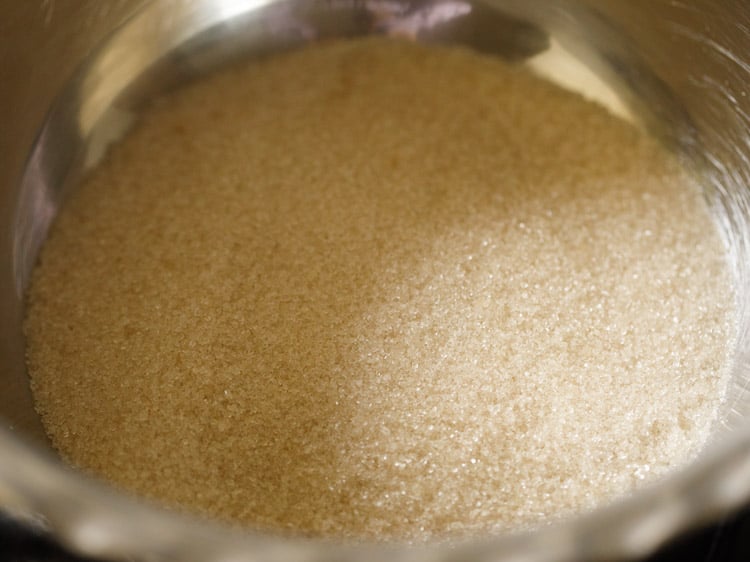
13. Add ½ cup water.
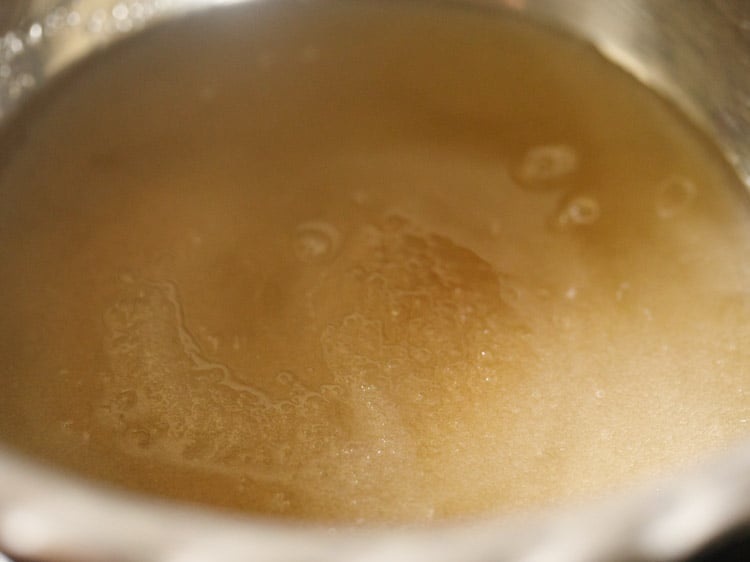
14. Stir to mix.
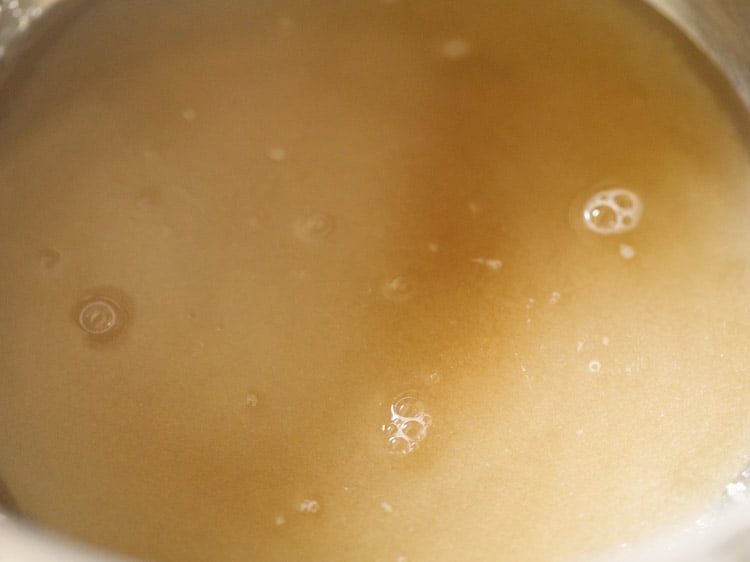
15. Place the pan on low heat.
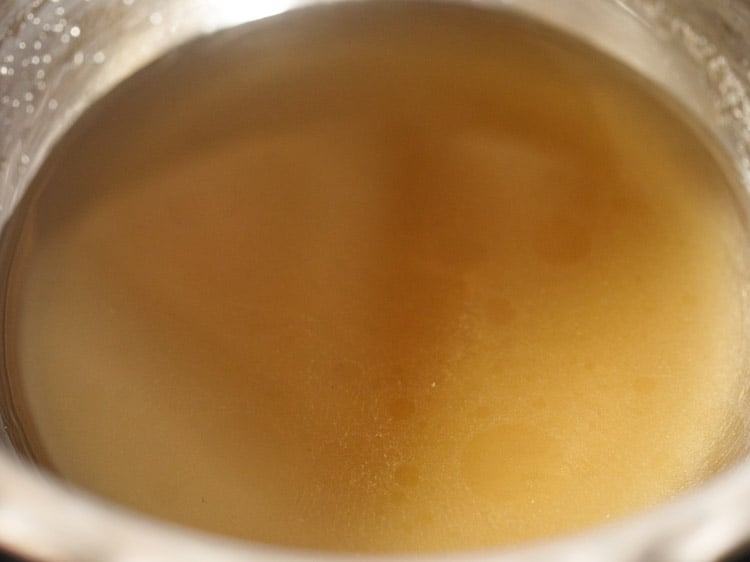
16. Using a spoon, stir the sugar so that it dissolves. If there are impurities in the sugar syrup, then add 1 tablespoon milk. Remove the scum that forms at the top.
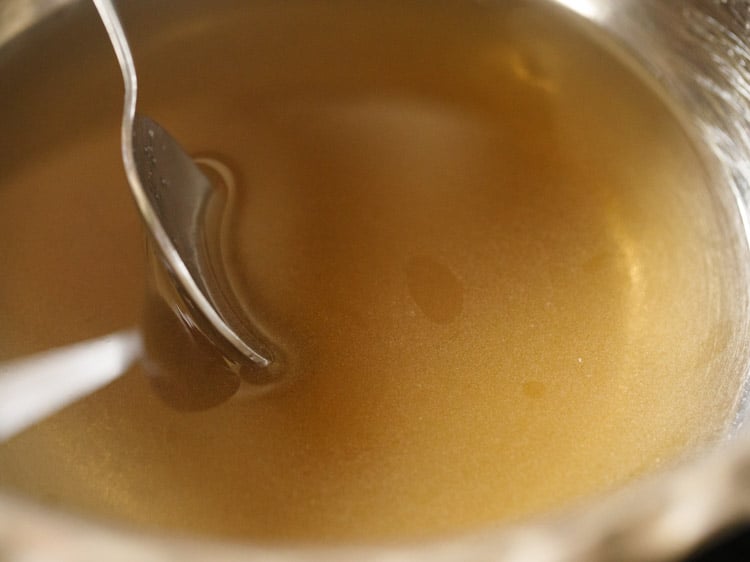
17. When all the sugar has dissolved, add ½ to 1 teaspoon cardamom powder.
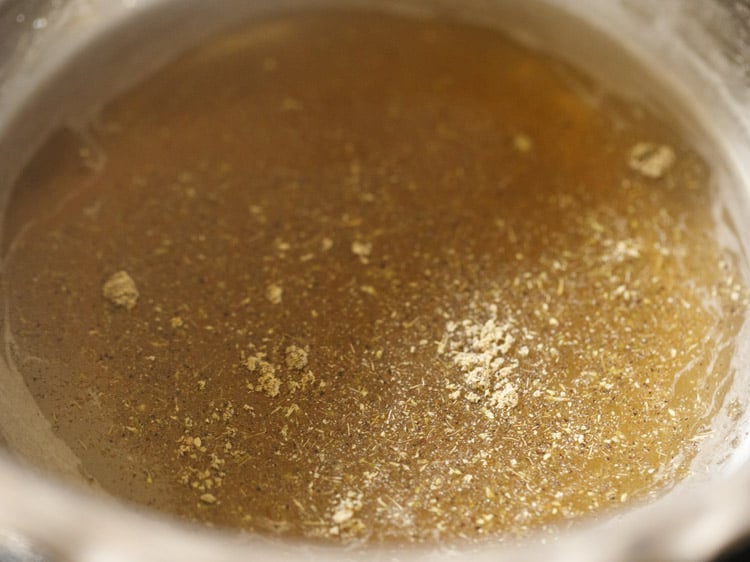
18. Add 10 to 12 saffron strands. Stir again.
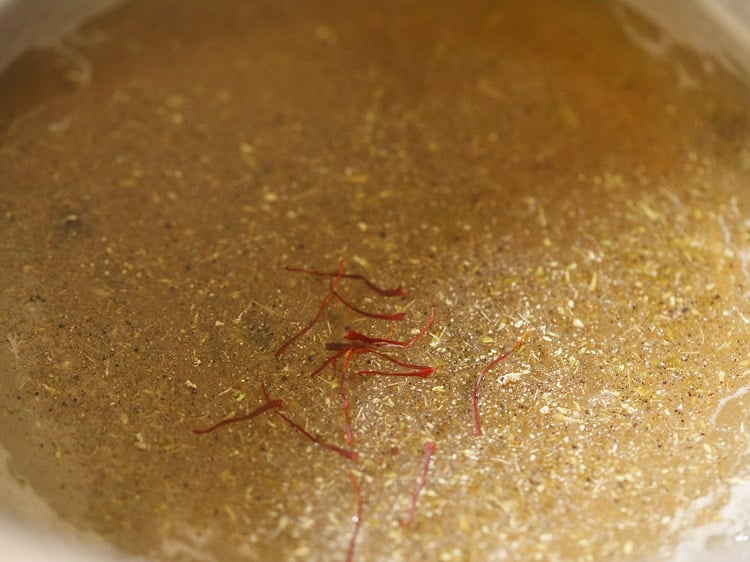
19. Simmer the sugar solution on low to medium-low heat. Stir occasionally. To avoid crystallization of sugar, you can add some drops of lemon juice.
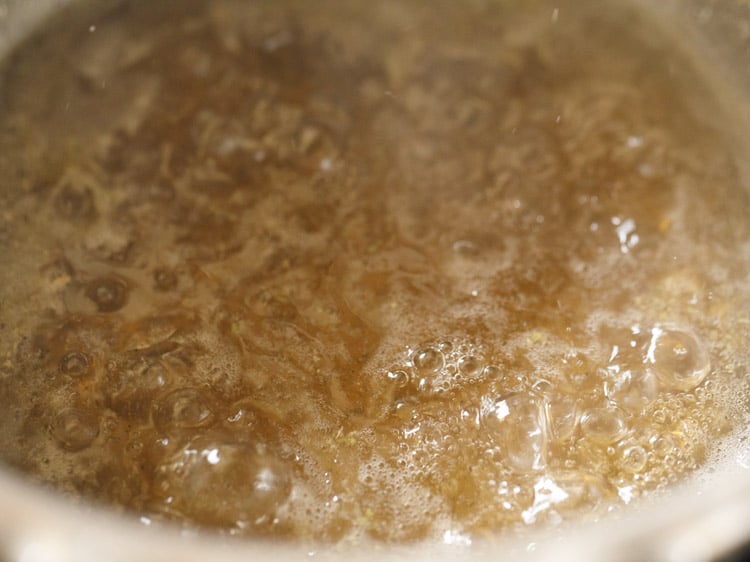
20. Simmer till the syrup becomes sticky or you get ½-string consistency in the syrup. You can even cook till 1-string consistency.
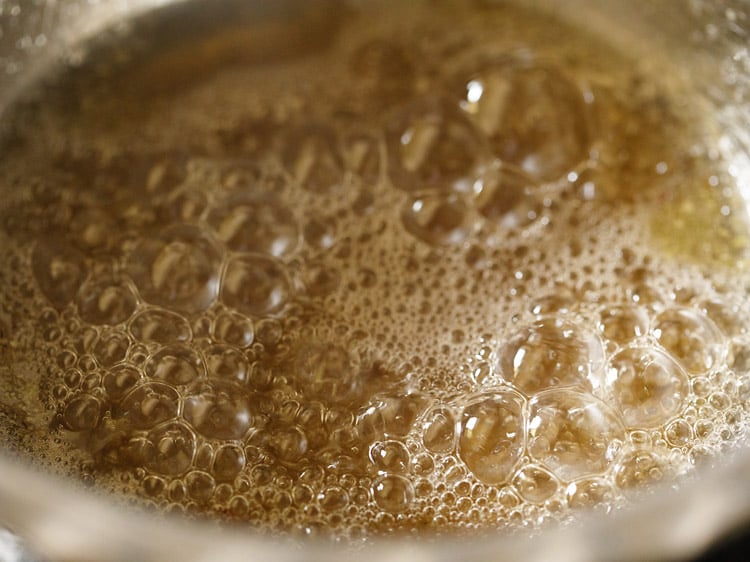
21. The syrup should be sticky. To check this, cool the syrup in a spoon and touch it. It should feel sticky. When the syrup becomes sticky, then switch off the heat.
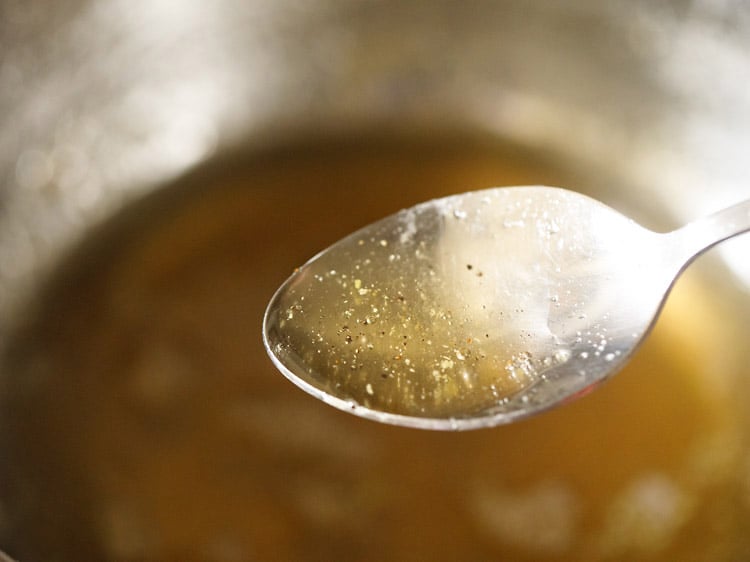
Shape and Fry Badushah
22. Before frying, you can begin to heat oil in a kadai or pan on a medium heat. Use a kadai with handles at the sides. You can also use ghee instead of oil, to fry Balushahi.
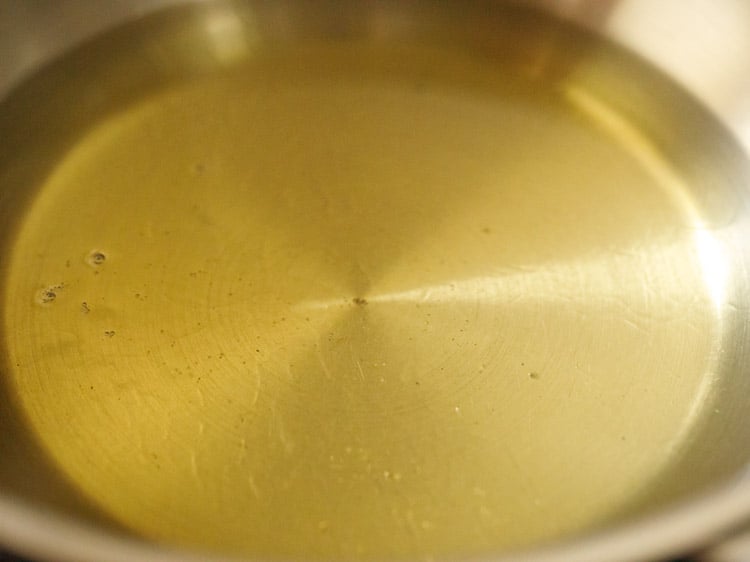
23. Pinch small to medium sized balls from the dough. Roll them gently and lightly between your palms.
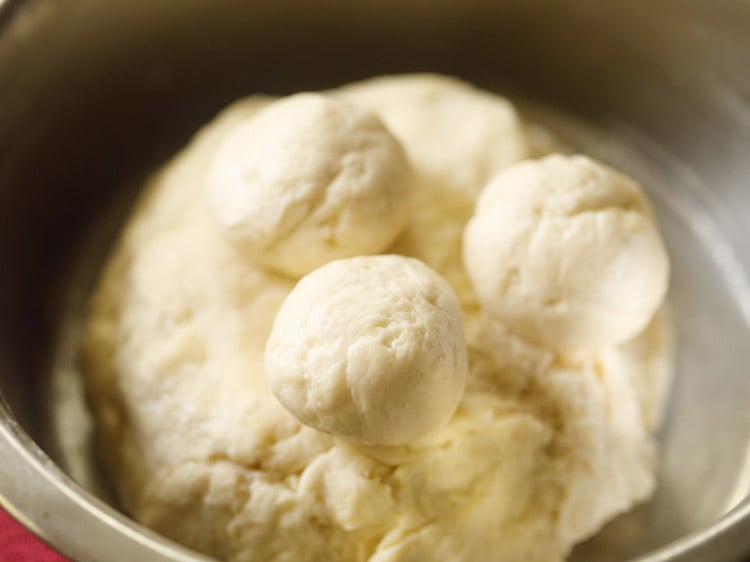
24. Then, make an indent or depression in them. You can flatten them slightly if you want. Cover remaining dough and keep aside.
Make 5 to 6 Badusha depending on the size of the kadai you will use for frying.
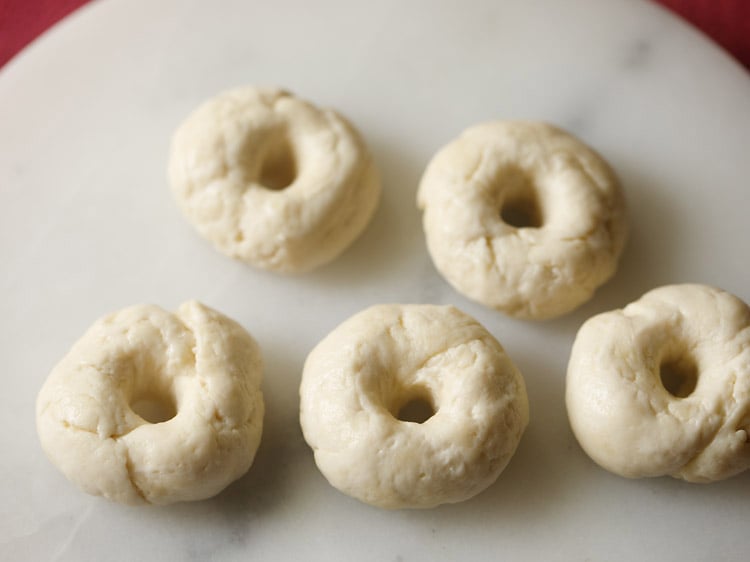
25. Check a tiny piece of the dough in the medium hot oil. It should come up gradually and steadily.
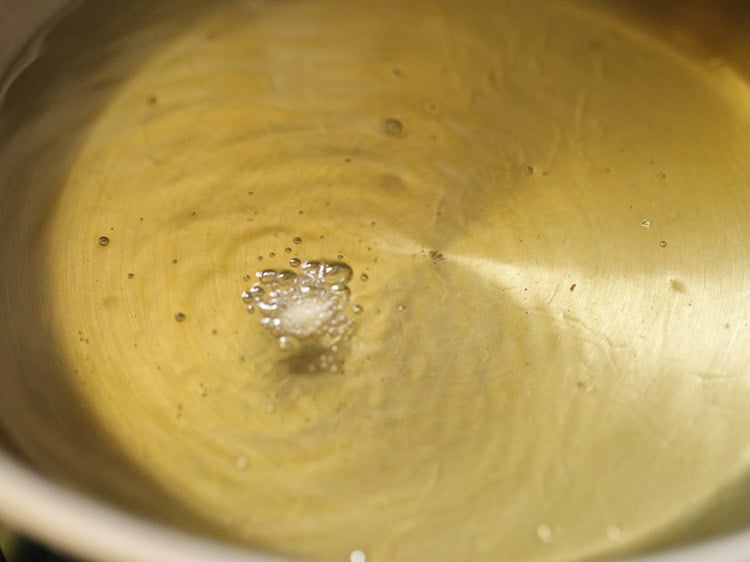
26. Now, lift the kadai from stovetop and keep it on the kitchen table top. Gently begin to place Balushahis in the hot oil.
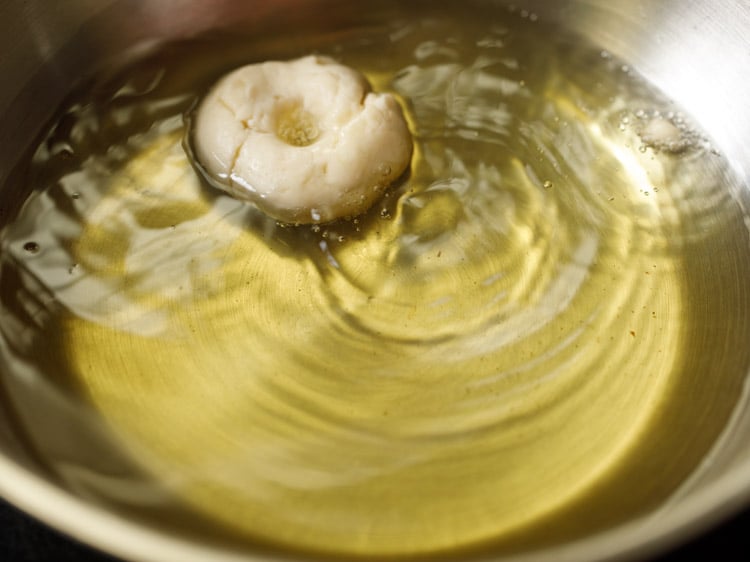
27. Be careful when you are adding Badusha in hot oil. Add 5 to 7 pieces depending on the size of kadai. The pieces will expand in oil while frying. So, make sure not to over crowd the kadai or pan.
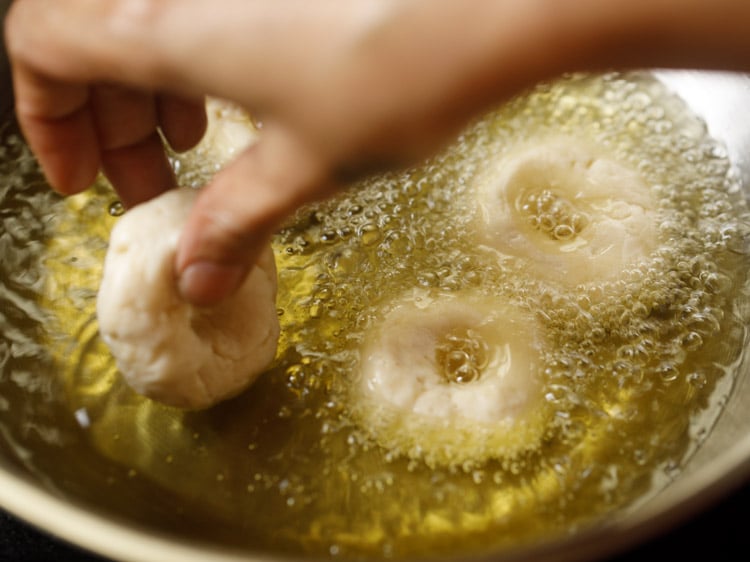
28. Now, lift the kadai and place it again on low to medium-low heat.
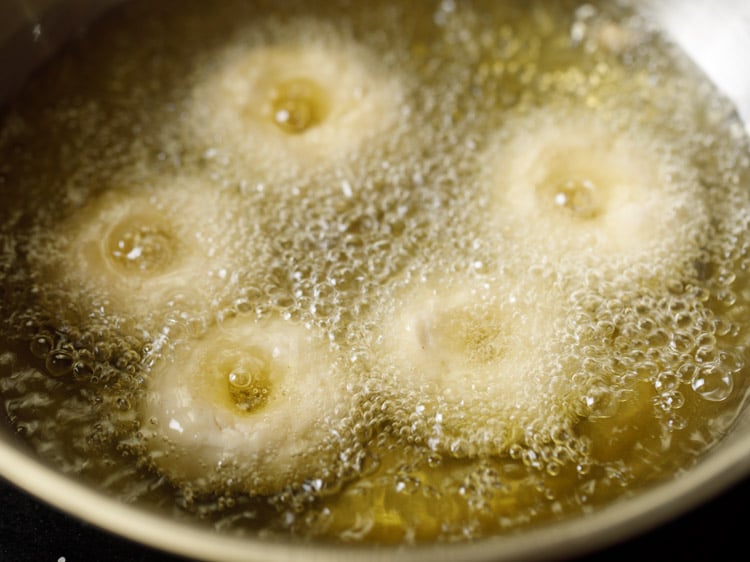
29. Begin to fry Badusha on low to medium-low heat.
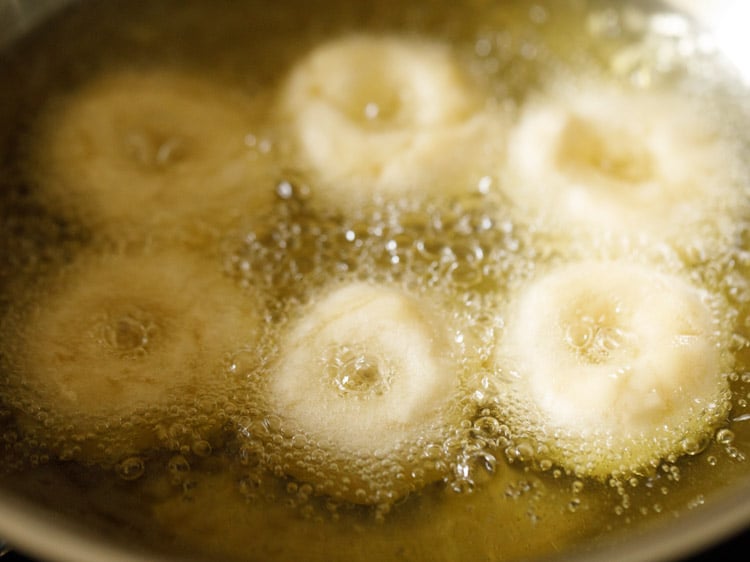
30. When one side firms up and is light golden, turn over each Balushahi.
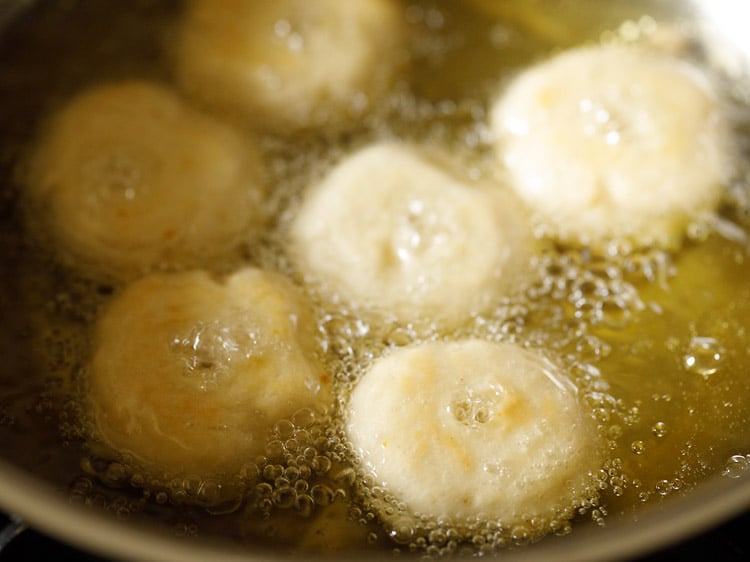
31. Keep on turning them at intervals and frying them on low to medium-low heat.
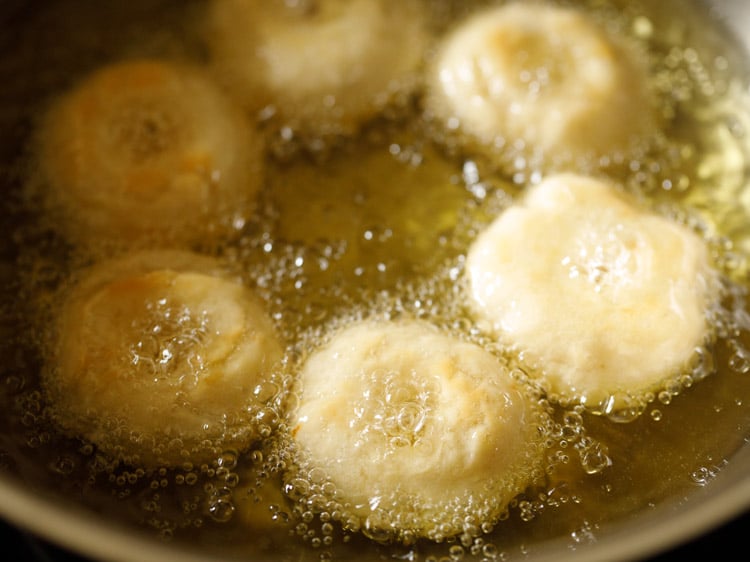
32. Frying balushahi on low heat takes about 12 to 15 minutes. This will depend on the size, thickness of kadai and the intensity of flame.
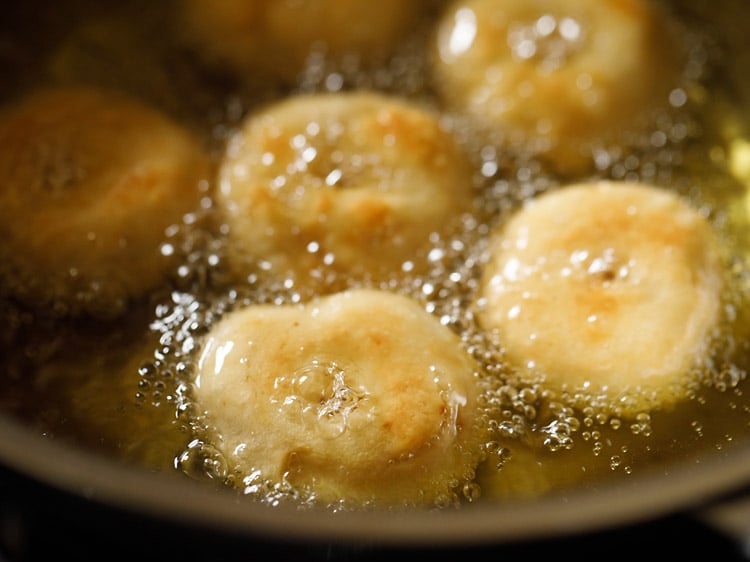
33. It took me 14 minutes to fry each batch of 6 Balushahi.
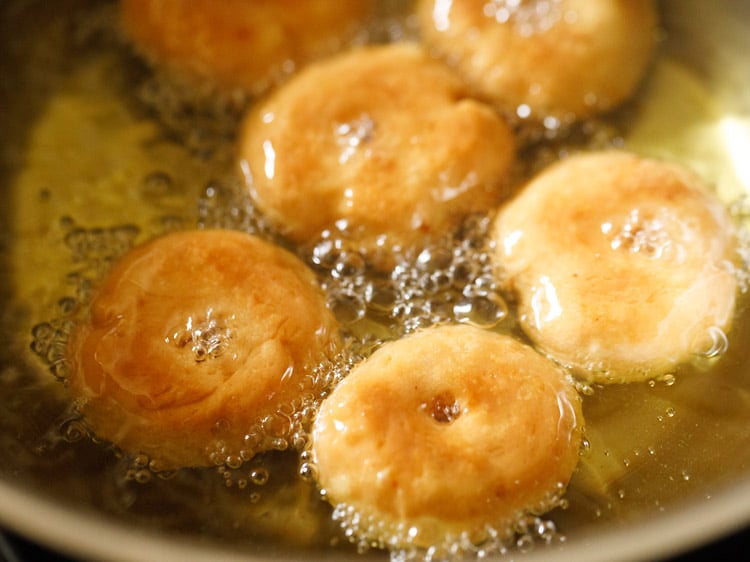
34. Fry Badusha till golden and crisp.
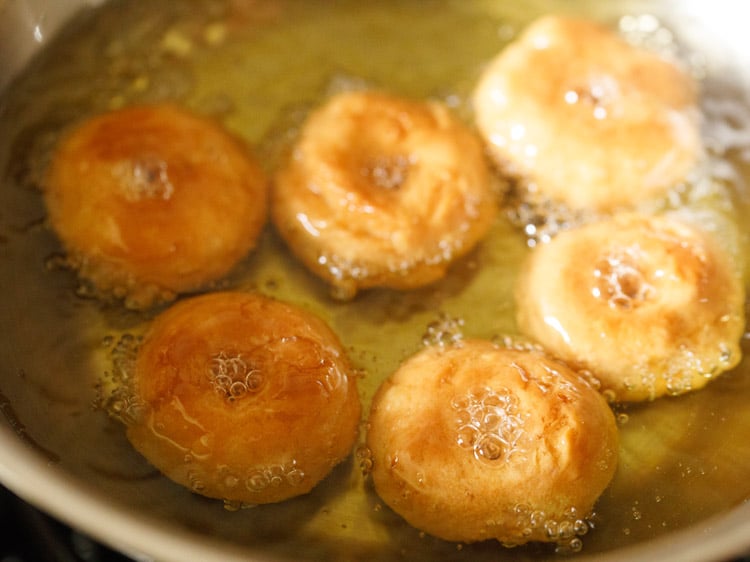
35. Using a slotted spoon, remove the fried pieces, draining the extra oil.
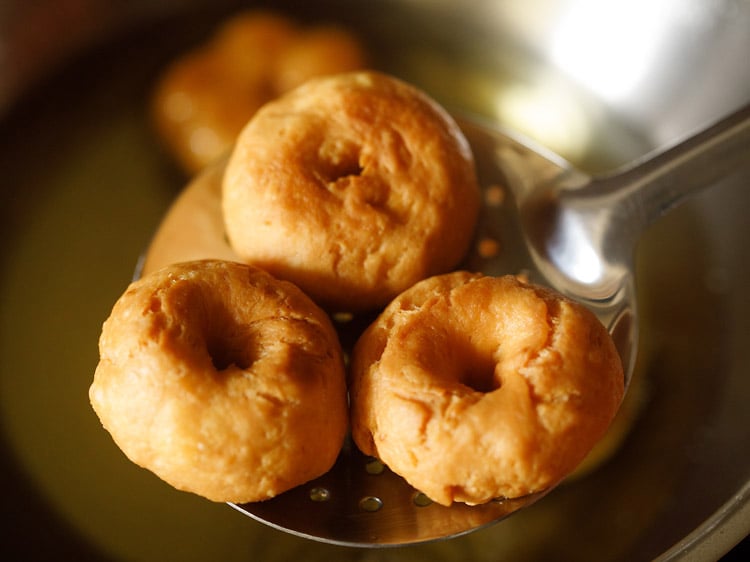
36. Place the fried Balushahi on kitchen paper towels. When the first batch is getting fried, you can make more from the dough and keep them ready to fry in the second round.
Keep them covered with a kitchen napkin. Then, fry the second batch in the same way the first batch was fried.
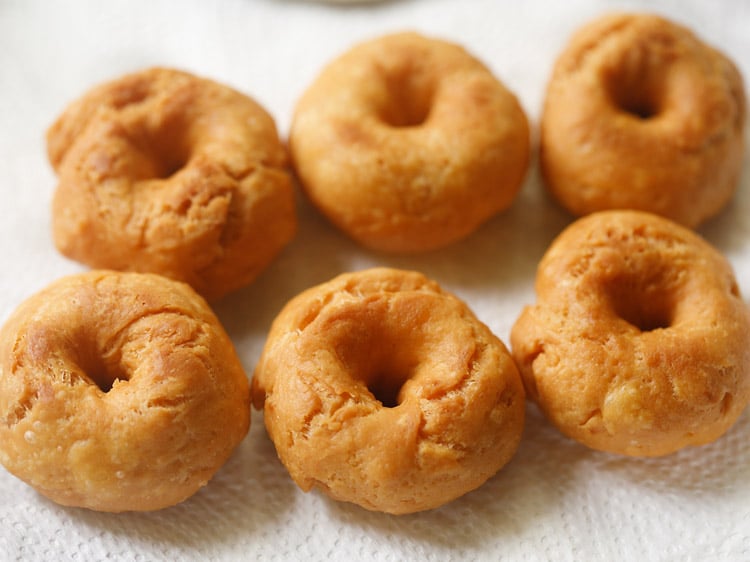
Coat With Sugar Syrup
37. After a couple of minutes, when still hot, place them in the hot or warm sugar syrup.
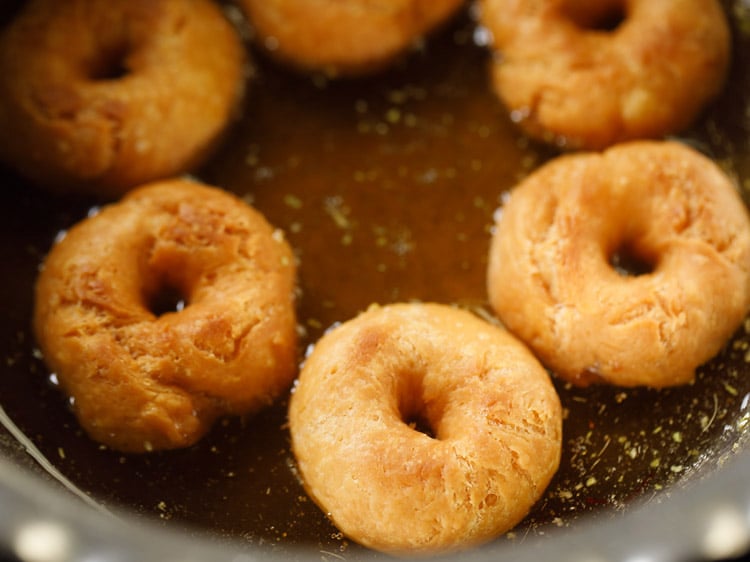
38. With spoon or tongs, turn over each Badusha, so that both sides are coated with sugar syrup. Let these soak in the sugar syrup for about 14 to 15 minutes.
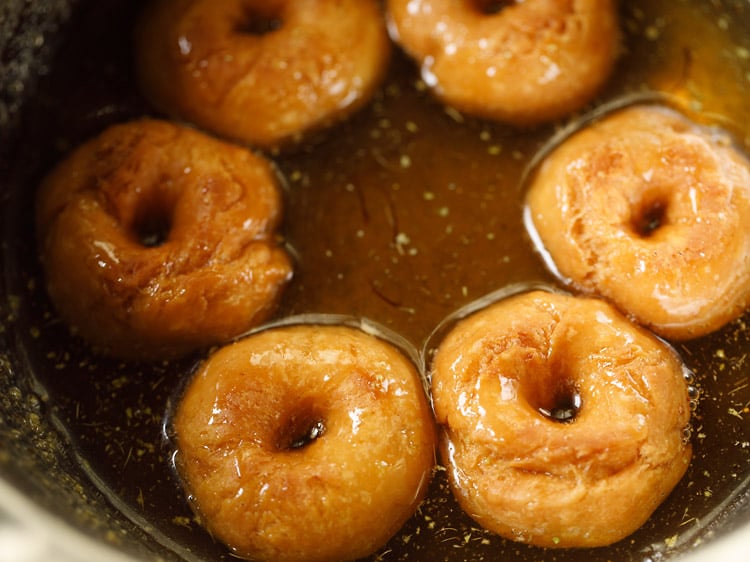
39. After 14 to 15 minutes, using tongs or spoon, lift each sweet and place it in a serving tray or bowl.
In the same sugar syrup, add the second batch. After the sweets cool completely, the sugar will crystallize on top.
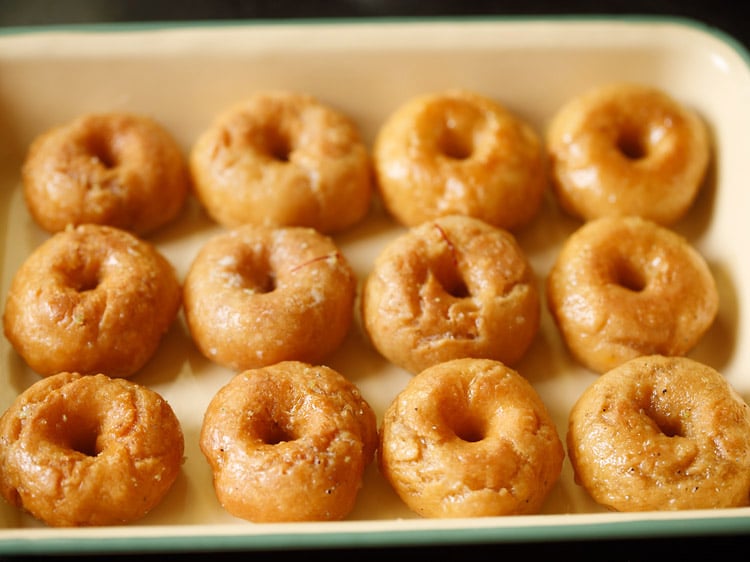
40. Sprinkle 1 to 2 tablespoons chopped pistachios all over. You can even sprinkle some saffron strands, rose petals and cardamom powder, if you want. Press the pistachios, so that they stick to the sugar syrup on the sweet.
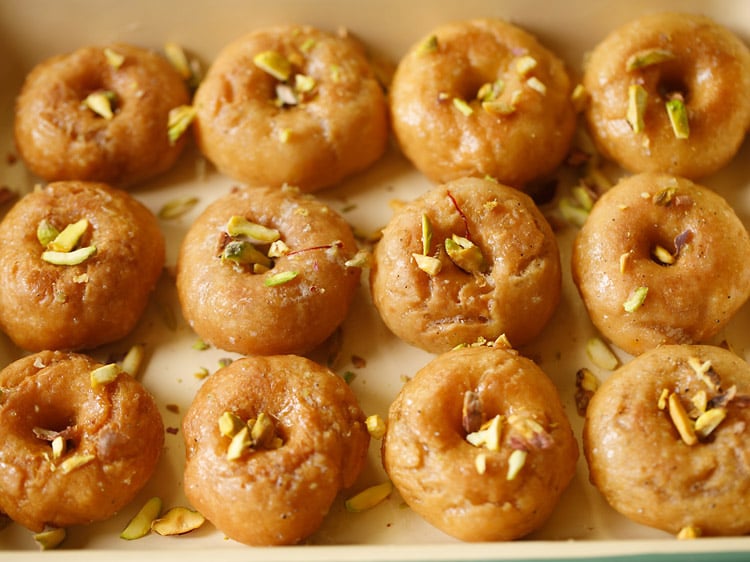
41. Fry the remaining badhusha and then soak them in the sugar syrup. In case if sugar syrup crystallizes, then add 2 to 3 tablespoons water and warm or heat the syrup again on low heat.
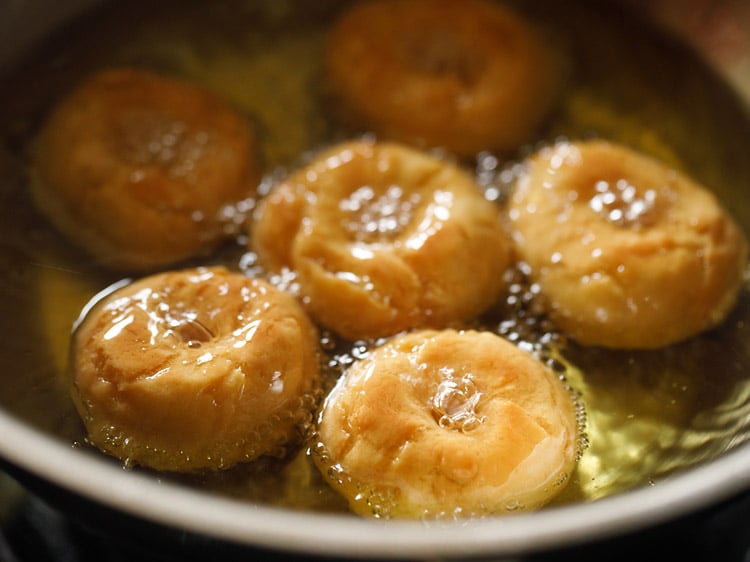
42. Serve Badusha Sweet. Leftovers can be stored in an air-tight jar or container at room temperature for about 5 to 6 days.
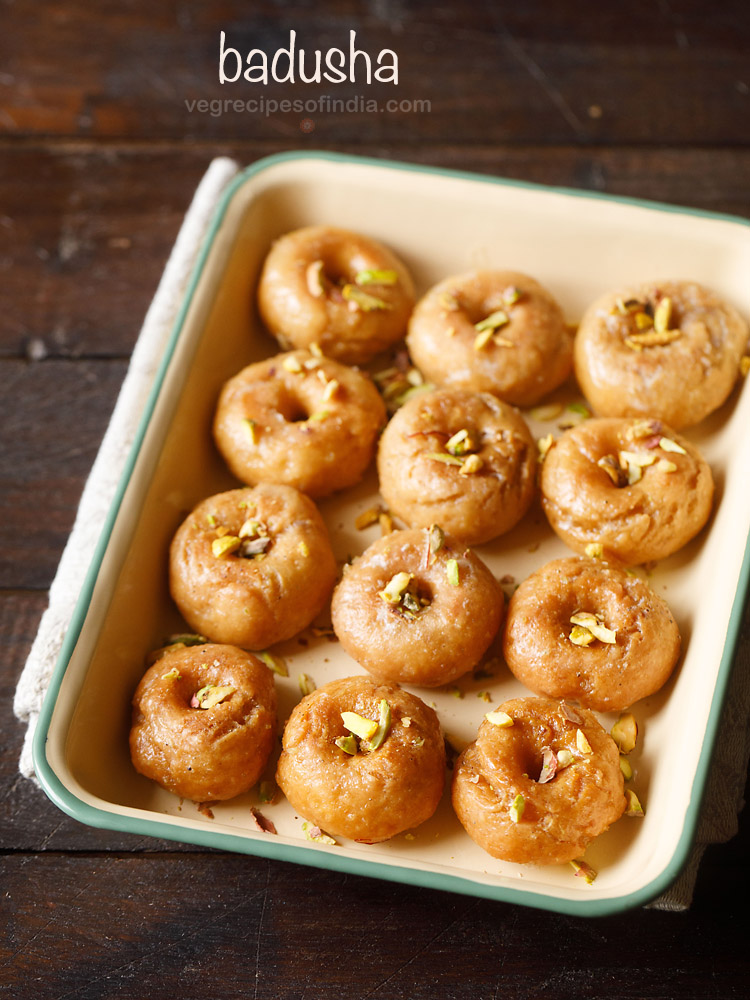
Expert Tips
- If you are adding curd or yogurt which has more whey, then you will have to add less water while forming the dough.
- While making the dough, make sure you are not kneading the mixture heavily and just bringing everything together, using light hands, to form a soft dough. If you have a sticky dough, then add about 1 to 2 tablespoons more of all-purpose flour.
- While making the sugar syrup, if there are impurities in it, then add 1 tablespoon milk. Remove the scum that forms on top.
- In order to avoid crystallization of sugar, add some drops of lemon juice in the sugar syrup.
- You have to cook the sugar solution till you get a syrup becomes sticky and you get a ½ or 1-string consistency in it.
- Note that the time taken to fry the sweet will depend on the size and thickness of the pan or kadai, and the intensity of the flame.
- You can opt to garnish the sweet with your preferred nuts and even with flavorings like saffron strands, rose petals or green cardamom powder.
- While frying more batches, if the sugar syrup crystallizes, then add about 2 to 3 tablespoons of water in it. Then, warm or heat it again on low heat.
More Diwali Sweets To Try!
Sweets Recipes
Sweets Recipes
Sweets Recipes
Ladoo Recipes
Please be sure to rate the recipe in the recipe card or leave a comment below if you have made it. For more vegetarian inspirations, Sign Up for my emails or follow me on Instagram, Youtube, Facebook, Pinterest or Twitter.
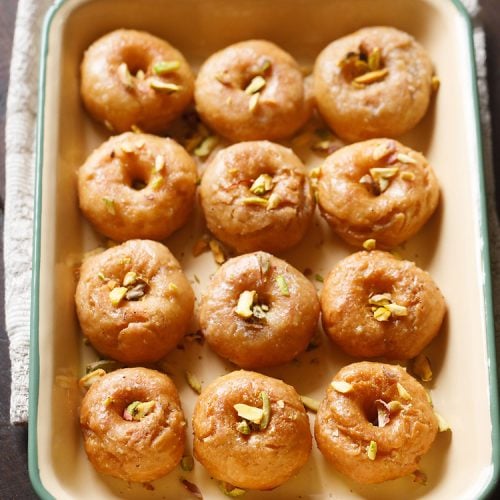
Balushahi Recipe | Badusha Sweet
Ingredients
For balushahi dough
For sugar syrup
- 1 heaped cup sugar – 200 grams
- ½ cup water
- ½ to 1 teaspoon cardamom powder or add as required
- 10 to 12 saffron strands
- 2 to 3 drops lemon juice – optional
Other ingredient
- oil or ghee for deep frying, as required
For garnish
- 1 to 2 tablespoons chopped pistachios or almonds or preferred nuts
Instructions
Creaming ghee
- Take ¼ cup ghee in a bowl.
- With a spoon or spatula or a small wired whisk, beat the ghee till it is smooth, light and fluffy. Its color will also lighten.
- Add ¼ cup chilled fresh curd (dahi).
- Again with a spoon or spatula or a small wired whisk, mix and whip the curd with the creamed ghee.
- Cream till light and smooth.
Making badusha dough
- Now using a sieve, take the all-purpose flour in it. Place it on the bowl itself. You can also sift the flour separately in a plate or tray.
- Add 1 pinch salt, 1 pinch baking soda and ½ teaspoon baking powder.
- Sift directly in the creamed ghee and curd.
- Mix the flour lightly with the creamed ghee and curd using a spoon or spatula.
- Sprinkle some cold water in parts and begin to mix it. Overall you can use 8 to 9 tablespoons cold water. Add 2 to 3 tablespoons water at a time and mix.
- Mix and combine everything to form a soft dough. Do not knead. Just mix and bring everything together to a dough. In case the dough becomes sticky, then add 1 to 2 tablespoons flour. Use light pressure from hands and form a dough. At this point, do not knead heavily or if required then knead very lightly.
- Cover the dough and keep aside for 15 minutes.
Making sugar syrup
- Meanwhile make sugar syrup. While frying balushahi also you can make sugar syrup. Take 200 grams sugar or 1 heaped cup of sugar in a pan or bowl. Use a bowl or pan with more surface area so that the balushahi can get enough space for soaking.
- Add ½ cup water and mix.
- Place the pan on a low heat.
- Using a spoon stir the sugar so that it dissolves. If there are impurities in the sugar syrup, then add 1 tablespoon milk. Remove the scum that forms at the top.
- When all the sugar has dissolved, add ½ to 1 teaspoon green cardamom powder. Then add 10 to 12 saffron strands. Stir and mix again.
- Simmer the sugar solution on a low to medium-low heat. Do stir occasionally. To avoid crystallization of sugar, you can add some drops of lemon juice.
- Simmer till the syrup becomes sticky or you get ½ string consistency in the syrup. You can even cook it to 1 string consistency.
- The sugar syrup should be sticky. So cool syrup in a spoon and touch it and it should feels sticky. When the syrup becomes sticky, then switch off heat.
Frying balushahi
- Before frying balushahi you can begin to heat oil in a kadai or pan on a medium heat. You can also use ghee instead of oil to fry balushahi.Do use a kadai with handles at the sides.
- Pinch small to medium-sized balls from the dough. Roll them gently and lightly between your palms.
- Then make an indent or depression in them. You can flatten them slightly if you want. Make 5 to 6 badhusha depending on the size of kadai.Cover the remaining dough and keep aside.
- Check a tiny piece of the badhusha dough in the medium hot oil. It should come up gradually and steadily.
- Now lift the kadai from stove top and keep it on the kitchen table top. Gently begin to place balushahi in the hot oil.
- Be careful when you are keeping the balushahi in hot oil. Add 5 to 6 or 7 balushahi depending on the size of kadai. The badushah will expand in oil while frying, so make sure not to over crowd the kadai or pan.
- Now lift the kadai and place it again on a low heat.
- Begin to fry badusha on a low heat.
- When one side firms up and is light golden, turn over each badusha.
- Keep on turning them over at intervals and frying them on a low heat.
- Frying balushahi on a low flame takes about 12 to 15 minutes. This will depend on the size, thickness of kadai and the intensity of flame. It took me 14 minutes to fry each batch of 6 balushahi.
- Fry till golden and crisp.
- Using a slotted spoon remove them draining the extra oil.
- Place them on kitchen paper towels. When the first batch is getting fried, you can make balushahi from the dough and keep them ready to fry in the second round. Keep the shaped and prepared balushahi covered with a kitchen napkin. Then fry the second batch of balushahi in the same way.
Making balushahi
- After a couple of minutes, when fried balushahi are still hot, place them in the hot or warm sugar syrup.
- With spoon or tongs turn over each badusha, so that both sides are coated with sugar syrup. Let these badusha soak in the sugar syrup for about 14 to 15 minutes.
- After 14 to 15 minutes, using tongs or spoon, lift each balushahi and place it in a serving tray or bowl. In the same sugar syrup, now add the second batch of balushahi.
- Sprinkle 1 to 2 tablespoons of pistachios all over. You can even sprinkle some saffron strand, rose petals and cardamom powder if you want. Press the pistachios, so that they stick to the sugar syrup on the badusha.
- Fry the remaining badusha and then soak them in the sugar syrup. In case if sugar syrup crystallizes then add 2 to 3 tablespoons water and warm or heat the syrup again on a low flame.
- Serve Balushahi as a sweet. Leftovers can be easily stored in an air-tight jar or container at room temperature for about 5 to 6 days.
Notes
- Remember not to knead the dough. Gently mix with a spoon and form to a evenly mixed dough.
- Ensure that the ghee is grainy and in a semi-solid state. It should not be melted, runny or cold and solidified.
- Follow the frying method as mentioned in the recipe.
- The recipe can be scaled to make a smaller portion or a big batch of balushahi.
- The approximate nutrition info is for one balushahi made from the recipe.
Nutrition Info (Approximate Values)
This Balushahi recipe post from the archives, first published on June 2018 has been updated and republished on October 2022.
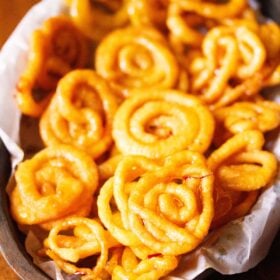
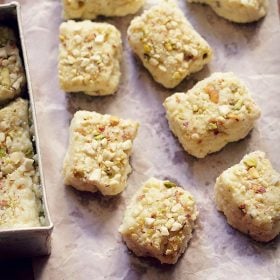
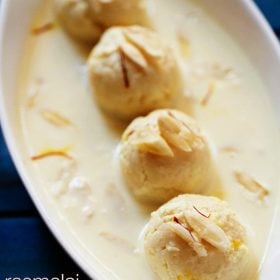
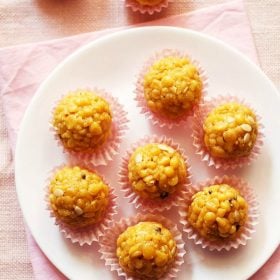
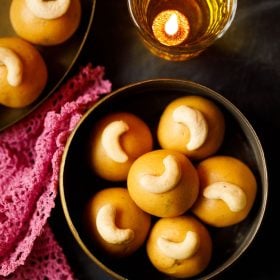
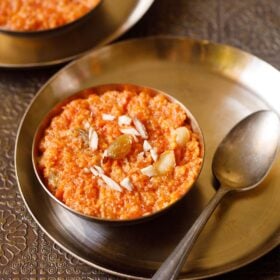
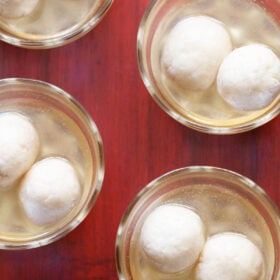
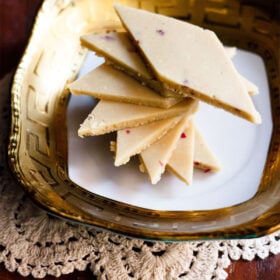








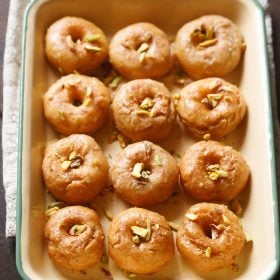
Amazing recipe. I realised that sugar syrup consistency is very important after reading other reviews and your reply to that challenge.
I am making these and have lost count how of many times and functions I made these for. Bless you loads
Great! Thanks for sharing your honest feedback. Agree, the sugar syrup consistency is very important here. Thanks for the rating too.
Very well explained. Will definitely try this recipe!
Thanks and I hope you like the recipe.
Hi i made your recipe and they came out awesome. All your recipes are so good. Thanks for the recipe. Can you please give recipe for khaja
Thank you Sridevi. I have noted down your recipe request and will add in some time.
Tried the same… Awesome taste
Thanks for the feedback and rating.
Hi. I tried the recipe. It turned out very well. Thanks for sharing. Much appreciated
Great to know and thanks for sharing the feedback. Welcome.
Hello Maam
I am a great fan of your recipes ..i am planning to make badushas..i just wanted to know if we can make it using whole wheat flour too..also should we use both baking soda and baking powder??
nandhini, you can make badusha with whole wheat flour. you can skip baking soda. just add 3 pinches more of baking powder if not using baking soda.
Mam phle apka cooking app tha bt ab app ni show hota h apka app install krna cahti hu
rachna, we had the app earlier, but we removed it more than a year back. now all the recipes are listed on the website.
Hello Ma’am, i have tried ur recipe of balu shahi nd it turned out to be really good. The taste was so good.. its texture, the size everything was good. BUT the balu shahis, later on would become gooey. It didn’t remain the same crispy which it was earlier. I have followed each nd every step which u mentioned here. Can u plz tell me where i would have gone wrong?
thanks sakshi for the feedback. from your comment it looks like the balushahi texture itself was good when fried. problem has happened with the sugar syrup. looks like 1/2 string consistency was not formed. it must have been a liquidy sugar solution. stickiness should be felt. the sugar syrup should not feel watery. looks like the sugar syrup was not sticky or with 1/2 string consistency and thus the balushahi has absorbed the sugar syrup making it soft and gooey. must be like gulab jamun texture. thats what i am guessing. i hope these tips help you.